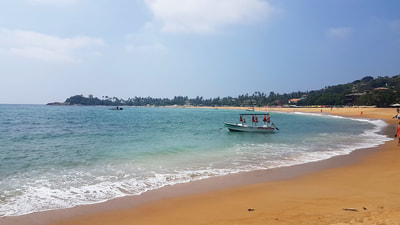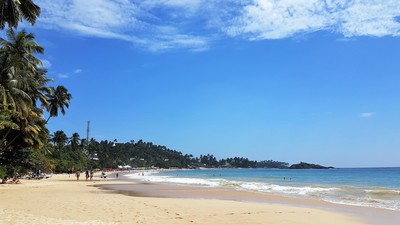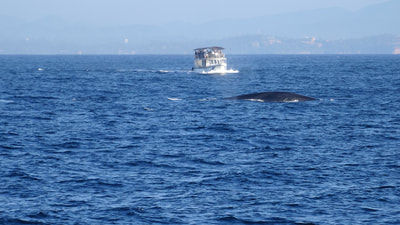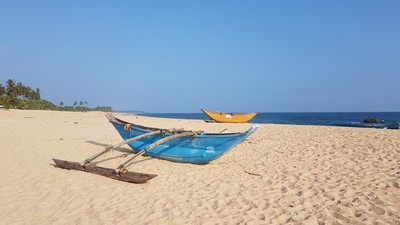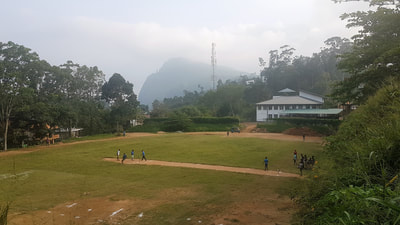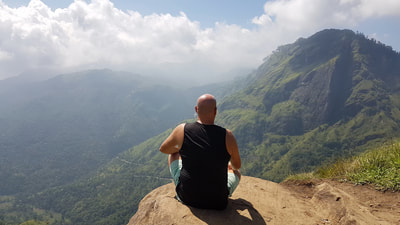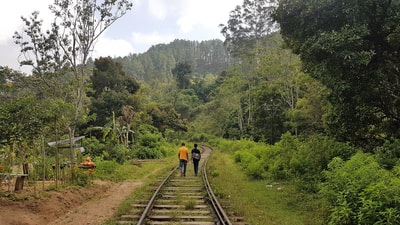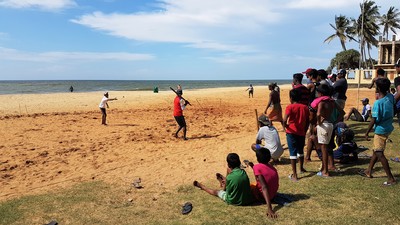|
Just a few kilometres tuk-tuk ride from the resort town of Unawatuna lies Fort Gallé. This fort was built in 1588 by the Portuguese and then extensively fortified by the Dutch during the 17th century. Nowadays this place is an UNESCO World Heritage site.
To get a good impression of the fort I went to the fort in the morning and walked along the fort wall. This walk was about 2 kilometres and I saw some historical landmarks within the fort like the Galle lighthouse, the Meera Mosque, the Dutch Reformed Church and the Old Dutch Hospital. At noon I returned to Unawatuna for a last afternoon on the beach. Next day I went back to Negombo for a last night in Sri Lanka and to get an early morning flight back to Dubai.
0 Comments
My last stop on the Sri Lankan south coast was Unawatuna. This coastal town has a beautiful long beach with a scenic budha statue on one of the sides.
Since I only had time left for a two nights stay (1 full day) I didn't go for some scuba dives with one of the many diving schools but I spend time at the nearby UNESCO World Heritage site of Gallé Fort. In the evenings I enjoyed some the seafood served at the restaurants on the beach. I continued my trip from Tangalle to Mirissa, close to the Southern tip of the island and only about 200km from the equator. Mirissa beach is split by the Parrot Rock. One side is a perfect sandy beach that slides slowly into the ocean. I spend the days on the beach; reading, chilling, working on my tan and drinking happy hour sunset beers. In the evenings I returned to the beach for fresh BBQ-grilled fish.
The biggest reason to visit Mirissa was that it is probably the best place in the world to see blue whales. The blue whale is the largest animal ever known to have lived. Since the deeper waters around Mirissa are rich in plancton, there is supposed to be a resident population always present. The morning whale watching tour was a great experience. After a few kilometres from Mirissa harbour the first signs of blue whales were present. The art to spotting whales comes down to mastering their breathing behaviour. Blue whales have lungs instead of fish gills. Therefore they need to come to the surface of the ocean to spout the air out of their blow-holes. They then stay onshore dipping in and out of the water. around 3-4 times, breathing in and out. Finally they take one last long breath before making a dive down for food (shown by the tail above the surface). We saw this ritual at least ten times. After taking a taxi for the rides through hill country I decided to take a local bus from Udawalawe to the south coast otf the island. At crazy speed the bus arrived 2,5 hours later in Tangalle. Tangalle is the furthest beach option on de Deep South Coast before the jungle of Yala takes over. Therefore it is still an off-the-beaten-track beach area.
Since I really enjoy deserted beaches, I booked myself a room in Serein Beach hotel located 1,5km north-east from Tangalle town. Within a few steps I found myself on the white unpolluted Medilla beach, a spit of land between the Indian Ocean and a lagoon. Because of strong undercurrents the sea is not ideal for swimming. However I enjoyed 3 days walking the beaches and reading a book in a hammock. It felt sometimes like I was having the whole beach for myself. One of the must-do's in Sri Lanka is visiting a National Park to spot some wildlife. Between the hill country and the southern coast lies the Udawalawe National Park. For me a perfect stop-over before I hit the unspoiled beaches of Tangalle. Since Udawalawe NP is home to a population of over 400 elephants, spotting elephants is almost guaranteed.
I arrived in the afternoon in Udawalawe, where I spend the night in the Lizard Safari Lodge. Next day I was picked up by a Jeep to be at the gate of the National Park at 6am. We started the safari spotting numerous birds waking up during sunset. And after 15 minutes we spotted the first group of elephants. On our way to the Walawe Reservoir we spotted countless number of peacocks, other birds, monkeys, crocodiles and buffalo's. When our Jeep stopped at the reservoir we were surrounded by elephants. And we had plenty of time to enjoy the sighting of these animals feeding themselves with grass. After 3 hours in the National Park it was time to return to the safari lodge. With the amazing experience of this game drive in my backpack, I was ready to continue my travels to the beach. Because of the chaotic traffic and the winding roads the taxi ride from Kandy to Ella was far from relaxing. Therefore it was a relief to arrive in the small backpacker-hub on the southern edge of Sri Lanka's hill country.
With a handful of shops, bars and restaurants, Ella is a perfect base for exploring the surrounding hills. There are plenty of hotels and guesthouses (and still more are build) and I stayed at a guesthouse with a terrace view on Ella Rock. Ella is the hiking hotspot Sri Lanka's hill country. Since I didn't fancy a challenging hike, I did a fairly easy trek to Little Adam's Peak. This hill got its name from its big brother, the holy mountain Adam's Peak, due to the similar shape. The path goes through tea plantations and it took me about an hour to get to the top (1141m). On my way back I descended to the Nine Arches bridge between Ella and Demodara railway stations. The historical brick bridge is still in use to take the trains from Kandy to Badulla. As the railway strikes continued for some more days, the rails were empty and I decided to walk along the track back to Ella railway station. This way I still managed to get an impression of the famous train ride through the hill country. Although I wasn't crossing the hill country from Kandy to Ella by train I could still enjoy the scenery by taxi. Around Nuwara Eliya (with a temperate and cool climate)) are many tea plantations on the hill slopes. The taxi driver made a stop for me at one of the tea factories, so I could have a look inside.
A local bus took me in 4,5 hours from Negombo to Kandy. Kandy is Sri Lanka's second largest city. It is located in the center of the island and known as the cultural capital of Sri Lanka. It was the last capital of the ancient kings' era of Sri Lanka. The down-town city is crowded and polluted. But the Bogambara lake and the surrounding tropical hill country on the sides places it in a beautiful scenery.
My guesthouse was on the hills next to the lake and just a short walk to the Royal Palace of Kandy and the Temple of the Tooth. The temple houses a tooth relic of the Lord Buddha and is one of the most sacred places of worship and pilgrimage of the Buddhist world. The room with the casket with the actual tooth in it is opened three times a day. When I visited there were hundreds of Buddhists (all wearing white clothes) who were offering flowers for the tooth relic. For me this ceremony was way more interesting then the temple itself. Next to the Royal Palace are the Kandy National Museum and the World Buddhist Museum. The last mentioned museum demonstrates the expanding of Buddhism all around the world. At the Kandy Lake Club I watched a show of Kandyan dancing, the traditional form of dancing in Sri Lanka. Another activity during my two full days in Kandy was climbing the hill with the omnipresent Buddha statue that can be seen from everywhere in Kandy city. From this place I had a perfect view on down-town Kandy and the Bogambara lake. My plan was to take the train from Kandy, through the central hill country, to Ella. This 7-hours train ride is supposed to be one of world's most scenic train rides. Unfortunately one day before I was supposed to take the train the railway employees started a national strike. Because I didn't fancy taking local busses through the hills, I had to take a taxi to Ella. I started my trip in Sri Lanka in Negombo because this city is the closest one to the Bandaranaike international airport. Here I gave myself 2 full days to get rid of the jet-lag and adjust to the tropical climate.
Negombo is situated on the west-coast of the Sri Lankan island along a wide beach. The majority of the people in Negombo is Christian, which is obvious by the amount of churches that are still there since Portuguese colonization. Although Negombo doesn't have many touristic sites, I enjoyed the walk on the beach to the fish market, the second-largest of the country. |
Places in Sri Lanka
All
Sri Lanka Archives |








